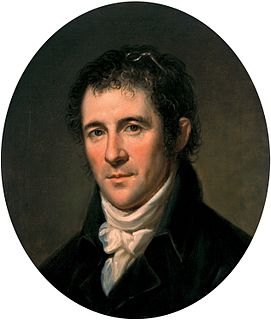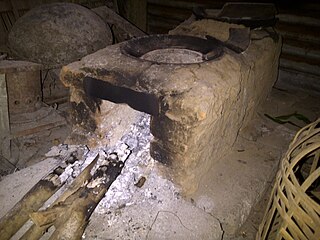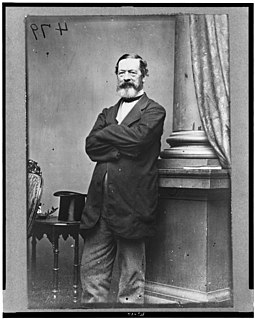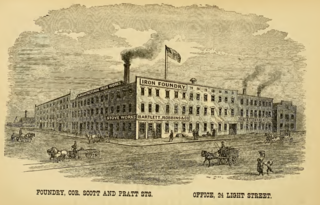Related Research Articles
Kerosene, paraffin, or lamp oil is a combustible hydrocarbon liquid which is derived from petroleum. It is widely used as a fuel in aviation as well as households. Its name derives from Greek: κηρός (keros) meaning "wax", and was registered as a trademark by Canadian geologist and inventor Abraham Gesner in 1854 before evolving into a generic trademark. It is sometimes spelled kerosine in scientific and industrial usage. The term kerosene is common in much of Argentina, Australia, Canada, India, New Zealand, Nigeria, and the United States, while the term paraffin is used in Chile, eastern Africa, South Africa, Norway, and in the United Kingdom. The term lamp oil, or the equivalent in the local languages, is common in the majority of Asia and the Southeastern United States. Liquid paraffin is a more viscous and highly refined product which is used as a laxative. Paraffin wax is a waxy solid extracted from petroleum.

Benjamin Henry Boneval Latrobe was a British-American neoclassical architect who emigrated to the United States. He was one of the first formally trained, professional architects in the new United States, drawing on influences from his travels in Italy, as well as British and French Neoclassical architects such as Claude Nicolas Ledoux. In his thirties, he emigrated to the new United States and designed the United States Capitol, on "Capitol Hill" in Washington, D.C., as well as the Old Baltimore Cathedral or The Baltimore Basilica,. It is the first Cathedral constructed in the United States for any Christian denomination. Latrobe also designed the largest structure in America at the time, the "Merchants' Exchange" in Baltimore. With extensive balconied atriums through the wings and a large central rotunda under a low dome which dominated the city, it was completed in 1820 after five years of work and endured into the early twentieth century.

A toaster is a small electric appliance designed to expose various types of sliced bread to radiant heat, browning the bread so it becomes toast.

Robert Mills, a South Carolina architect known for designing both the first Washington Monument, located in Baltimore, Maryland, as well as the better known monument to the first president in the nation's capital, Washington, DC. He is sometimes said to be the first native-born American to be professionally trained as an architect. Charles Bulfinch of Boston perhaps has a clearer claim to this honor.

The Franklin stove is a metal-lined fireplace named after Benjamin Franklin, who invented it in 1742. It had a hollow baffle near the rear and relied on an "inverted siphon" to draw the fire's hot fumes around the baffle. It was intended to produce more heat and less smoke than an ordinary open fireplace, but it achieved few sales until it was improved by David Rittenhouse. It is also known as a "circulating stove" or the "Pennsylvania fireplace".

A stove is a device that burns fuel or uses electricity to generate heat inside or on top of the apparatus. It has seen many developments over time and serves the main purpose of cooking food.

Thomas Ustick Walter was an American architect of German descent, the dean of American architecture between the 1820 death of Benjamin Latrobe and the emergence of H.H. Richardson in the 1870s. He was the fourth Architect of the Capitol and responsible for adding the north (Senate) and south (House) wings and the central dome that is predominately the current appearance of the U.S. Capitol building. Walter was one of the founders and second president of the American Institute of Architects. In 1839, he was elected as a member to the American Philosophical Society.
Latrobe or La Trobe may refer to:

Ferdinand Claiborne Latrobe was a seven-term Mayor of Baltimore, state legislator and attorney during the 19th century.

A masonry heater is a device for warming an interior space through radiant heating, by capturing the heat from periodic burning of fuel, and then radiating the heat at a fairly constant temperature for a long period. Masonry heaters covered in tile are called cocklestoves. The technology has existed in different forms, from back into the Neoglacial and Neolithic periods. Archaeological digs have revealed excavations of ancient inhabitants utilizing hot smoke from fires in their subterranean dwellings, to radiate into the living spaces. These early forms have evolved into modern systems.
Benjamin Henry Latrobe II was an American civil engineer, best known for his railway bridges, and a railway executive.

A convection heater is a type of heater that uses convection currents to heat and circulate air. These currents circulate throughout the body of the appliance and across its heating element. This process, following the principle of thermal conduction, heats up the air, reducing its density relative to colder air and causing it to rise.

A wood-burning stove is a heating or cooking appliance capable of burning wood fuel and wood-derived biomass fuel, such as sawdust bricks. Generally the appliance consists of a solid metal closed firebox, often lined by fire brick, and one or more air controls. The first wood-burning stove was patented in Strasbourg in 1557, two centuries before the Industrial Revolution, which would make iron an inexpensive and common material, so such stoves were high end consumer items and only gradually spread in use.
George Ellicott (1760–1832) was a son of Andrew Ellicott, who with his two brothers founded Ellicott's Mills, Maryland. He was a mathematician, an amateur astronomer, a younger cousin of surveyor Major Andrew Ellicott and a friend of Benjamin Banneker. He was the father of Martha Ellicott Tyson, who became an Elder of the Quaker Meeting in Baltimore, an anti-slavery and women's rights advocate, the author of a biography of Benjamin Banneker, a founder of Swarthmore College and an inductee to the Maryland Women's Hall of Fame.
Robert Grace was an American manufacturer of cast iron items including cannons, bells, furnaces and stoves. He is known for making the Pennsylvania Fire-Place, also known as the Franklin stove. Selling the parts he manufactured for the stove was a lucrative business for Grace.

John Hazlehurst Boneval Latrobe (1803–1891) was an American lawyer and inventor. He invented the Latrobe Stove, also known as the "Baltimore Heater", a coal fired parlor heater made of cast iron and that fit into fireplaces as an insert. He patented his design in 1846. The squat stoves were very popular by the 1870s and were much smaller than Benjamin Franklin's Franklin stove.

Bartlett-Hayward Company was a metalworking foundry located in Baltimore, Maryland founded in 1837. The company engaged initially in the production of latrobe stoves, but by the end of the nineteenth century, its Pigtown complex was the largest iron foundry in the United States, with a diverse output including cast-iron architecture, steam heating equipment, machine parts, railroad engines and piston rings.
SS John H. B. Latrobe was a Liberty ship built in the United States during World War II. She was named after John H. B. Latrobe, an American lawyer and inventor. He invented the Latrobe Stove, also known as the "Baltimore Heater", a coal fired parlor heater made of cast iron that fit into fireplaces as an insert.
United States Stove Company is an American manufacturer based in South Pittsburg, Tennessee that produces residential wood burning and pellet burning stoves and sells stove accessories and parts. Founded in 1869 by John S. Perry and S.L Rogers, the United States Stove Company is one of the largest manufacturers of both wood and pellet stoves in the United States, with its headquarters located in South Pittsburg, Tennessee.
References
- 1 2 Pbreber (October 11, 2016). "Forgotten history of Ellicott City & Howard County MD: John H. B. Latrobe's patented heating stove - Latrobe Stove - 1846". historichomeshowardcounty.Blogspot.com. Retrieved February 9, 2018.
- ↑ John Havelhurst Boneval Latrobe, Maryland State Archives
- ↑ Blake, Harriet L. (August 31, 1980). "Putting the Fire Back in Granny's Old Wood Stove" . Retrieved February 9, 2018– via www.WashingtonPost.com.